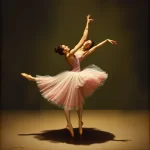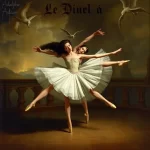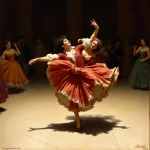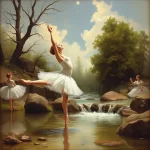Ballet: The Two Stars (Cesare Pugni, 1871)

Introduction
Ballet: The Two Stars, composed by Cesare Pugni in 1871, is a captivating work that has left an indelible mark on the world of dance. Choreographed by the renowned Marius Petipa, this ballet premiered on January 6, 1871, at the Imperial Bolshoi Kamenny Theatre in St. Petersburg, Russia. The ballet tells a poignant story of love, jealousy, and redemption, set against a backdrop of celestial imagery and human emotion.
Historical Background
Creation and Development
The creation of The Two Stars occurred during a period of significant artistic and social change in Russia. The late 19th century was a time of burgeoning national identity and cultural renaissance, with the arts playing a crucial role in expressing and shaping societal values. Ballet, in particular, was experiencing a golden age, with the Imperial Russian Ballet at the forefront of innovation and excellence.
The inspiration for The Two Stars came from a combination of literary sources and folklore. Petipa and Pugni drew upon celestial themes and romantic narratives, weaving them into a ballet that explored the complexities of human relationships and emotions. The collaboration between Petipa and Pugni was a harmonious one, with both artists bringing their unique talents to the project. Petipa’s choreography was known for its precision and elegance, while Pugni’s music provided a rich and emotive backdrop for the dancers.
Premiere and Reception
The Two Stars premiered on January 6, 1871, at the Imperial Bolshoi Kamenny Theatre in St. Petersburg. The initial reception was overwhelmingly positive, with critics and audiences alike praising the ballet for its innovative choreography, beautiful music, and compelling narrative. Notable early performances included revivals in major European cities, where the ballet continued to garner acclaim and attract large audiences.
Synopsis of the Ballet
Act I Summary
The ballet opens with a celestial scene, where two stars, represented by the lead characters, are introduced. These stars are personified as lovers who are separated by a jealous rival. The act sets the stage for the unfolding drama, with the introduction of key characters and the establishment of the central conflict.
Act II Summary
In the second act, the narrative shifts to a more earthly setting, where the human counterparts of the celestial lovers are revealed. The act explores their struggles and the obstacles they face in their quest to be reunited. Major turning points include moments of betrayal, misunderstandings, and the intervention of supernatural forces.
Act III Summary
The final act brings the story to its climax and resolution. The lovers are ultimately reunited, and the jealous rival is redeemed through acts of contrition and forgiveness. The ballet concludes with a grand finale that celebrates the triumph of love and the harmony of the celestial and earthly realms.
Finale
The conclusion of The Two Stars is both poignant and uplifting. The resolution of the central conflict and the reunion of the lovers underscore the ballet’s themes of love, redemption, and the interconnectedness of the celestial and human worlds. The finale is marked by a series of elaborate dance sequences that highlight the technical prowess and emotional depth of the performers.
Musical Composition
Composer’s Role
Cesare Pugni, an Italian composer known for his prolific contributions to ballet music, played a crucial role in the creation of The Two Stars. Pugni’s score for the ballet is characterized by its lyrical melodies, rich harmonies, and dynamic rhythms. Notable pieces within the score include the romantic pas de deux for the lead characters and the dramatic music that accompanies the climactic scenes.
Musical Themes and Motifs
The music of The Two Stars features several recurring themes and motifs that enhance the narrative and emotional impact of the ballet. Leitmotifs associated with the lead characters and their celestial counterparts are woven throughout the score, creating a sense of continuity and cohesion. The music also reflects the changing moods and dynamics of the story, from moments of tender intimacy to scenes of intense drama.
Famous Recordings and Performances
Over the years, The Two Stars has been performed by numerous prestigious ballet companies, and several recordings of Pugni’s score have been made. Iconic performances include those by the Mariinsky Ballet and the Bolshoi Ballet, both of which have contributed to the enduring legacy of the ballet. These recordings and performances have helped to preserve and disseminate Pugni’s music to new generations of audiences.
Choreography and Dance
Choreographer’s Vision
Marius Petipa’s vision for The Two Stars was one of elegance, precision, and emotional depth. Petipa’s choreography is characterized by its intricate patterns, graceful movements, and expressive gestures. He introduced several innovations in the choreography, including the use of complex lifts and partnering techniques that added a new dimension to the dance.
Signature Dance Numbers
The ballet features several key dance numbers that are central to its narrative and emotional impact. These include the romantic pas de deux between the lead characters, which showcases their love and connection, and the dramatic solo performances that highlight the inner turmoil and struggles of the characters. The choreography reflects the story and characters through its use of expressive movements and dynamic sequences.
Notable Interpretations
Over the years, different productions of The Two Stars have interpreted and adapted Petipa’s choreography in various ways. Some productions have emphasized the romantic and lyrical aspects of the ballet, while others have focused on its dramatic and emotional intensity. These interpretations have contributed to the ballet’s rich and diverse performance history.
Characters and Roles
Main Characters
The lead characters in The Two Stars are the celestial lovers, who are personified as human counterparts in the earthly setting. These characters are central to the narrative and are portrayed with depth and complexity. Their love story is the heart of the ballet, and their struggles and triumphs drive the plot forward.
Supporting Characters
Important secondary characters include the jealous rival, who serves as the antagonist, and various supernatural beings who intervene in the story. These characters add depth and complexity to the narrative, providing additional layers of conflict and resolution.
Famous Dancers
Over the years, many notable dancers have portrayed the lead and supporting roles in The Two Stars. These include legendary ballerinas and danseurs who have brought their unique talents and interpretations to the ballet. Their performances have contributed to the enduring legacy and popularity of the ballet.
Cultural and Artistic Impact
Influence on Ballet and Dance
The Two Stars has had a significant influence on the world of ballet and dance. Its innovative choreography, emotive music, and compelling narrative have inspired other works and choreographers. The ballet has played a crucial role in the development of ballet as an art form, pushing the boundaries of what is possible in dance and storytelling.
Cultural Significance
The ballet’s themes of love, jealousy, and redemption resonate with audiences across cultures and time periods. Its place in popular culture is reflected in various adaptations in film, theater, and other media. The Two Stars continues to be celebrated for its artistic and cultural significance.
Legacy and Revivals
The enduring legacy of The Two Stars is evident in the numerous revivals and reinterpretations of the ballet. Major ballet companies around the world continue to perform and celebrate the ballet, ensuring that its beauty and significance are preserved for future generations. Modern adaptations have brought new perspectives and innovations to the ballet, keeping it relevant and engaging for contemporary audiences.
Iconic Productions
Historic Productions
Some of the most famous historical productions of The Two Stars include those by the Imperial Russian Ballet and the Mariinsky Ballet. These productions featured key figures such as renowned dancers, directors, and set designers who contributed to the ballet’s success and legacy.
Contemporary Productions
Recent productions of The Two Stars have brought new interpretations and innovations to the ballet. Contemporary choreographers and directors have explored different aspects of the story and characters, creating fresh and engaging performances that resonate with modern audiences.
Production Design
The set, costume, and lighting design in various productions of The Two Stars have played a crucial role in bringing the ballet to life. From elaborate celestial backdrops to intricate costumes that reflect the characters’ personalities, the production design enhances the visual and emotional impact of the ballet.
Critical Reception and Reviews
Initial Critical Response
At the time of its premiere, The Two Stars received overwhelmingly positive reviews from critics. They praised the ballet for its innovative choreography, beautiful music, and compelling narrative. The initial critical response helped to establish the ballet’s reputation and popularity.
Modern Reviews
Contemporary critics and audiences continue to appreciate The Two Stars for its artistic and emotional depth. Modern reviews highlight the ballet’s timeless themes and its relevance to contemporary society. The ballet remains popular and continues to be performed by major ballet companies around the world.
Fun Facts and Trivia
Behind-the-Scenes Stories
Interesting anecdotes from the production of The Two Stars include stories of the collaboration between Petipa and Pugni, as well as the challenges faced by the dancers during rehearsals. These behind-the-scenes stories provide a glimpse into the creative process and the dedication of the artists involved.
Notable Performers
Famous dancers who have portrayed roles in The Two Stars include legendary ballerinas and danseurs who have left their mark on the ballet. Their performances have contributed to the ballet’s enduring legacy and popularity.
Trivia
- The Two Stars was one of the first ballets to explore celestial themes and imagery.
- Cesare Pugni composed over 300 ballets during his career, with The Two Stars being one of his most celebrated works.
- Marius Petipa is considered one of the greatest choreographers in the history of ballet, with The Two Stars being a testament to his genius.
Conclusion
Summary of the Ballet’s Importance
The Two Stars is a significant work in the world of ballet, known for its innovative choreography, beautiful music, and compelling narrative. It has had a lasting impact on the development of ballet as an art form and continues to be celebrated for its artistic and cultural significance.
Final Thoughts
The enduring legacy of The Two Stars is a testament to the genius of Cesare Pugni and Marius Petipa. Their collaboration resulted in a ballet that continues to captivate audiences with its beauty and emotional depth. For those who have not yet experienced The Two Stars, it is highly recommended to watch a performance or listen to the score to appreciate its timeless artistry.
FAQ
What is the central theme of this ballet?
The central theme of The Two Stars is the triumph of love over jealousy and adversity, set against a backdrop of celestial imagery and human emotion.
Who are the main characters in this ballet?
The main characters are the celestial lovers, who are personified as human counterparts in the earthly setting, and their jealous rival.
What is the most famous dance number in this ballet?
The most famous dance number is the romantic pas de deux between the lead characters, which showcases their love and connection.
How long does a typical performance of this ballet last?
A typical performance of The Two Stars lasts approximately two hours, including intermissions.
Are there any modern adaptations of this ballet?
Yes, there have been several modern adaptations of The Two Stars, with contemporary choreographers and directors bringing new interpretations and innovations to the ballet.
Why is this ballet considered important in the history of dance?
The Two Stars is considered important in the history of dance for its innovative choreography, beautiful music, and compelling narrative. It has had a lasting impact on the development of ballet as an art form and continues to be celebrated for its artistic and cultural significance.





